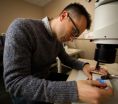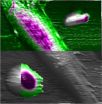(Press-News.org) Research by a team of Michigan State University scientists has shed new light on why some body parts are more sensitive to environmental change than others, work that could someday lead to better ways of treating a variety of diseases, including type 2 diabetes.
The research, led by assistant zoology professor Alexander Shingleton, is detailed in the recent issue of the Proceedings of the Library of Science Genetics.
In particular, Shingleton is studying the genetics of fruit flies and zeroing in on why some of the insects' body parts will grow to full size even when suffering from malnutrition, while others will not. He uses fruit flies because they use the same genes to control this process as humans.
"The developmental mechanisms by which these changes in body proportion are regulated are really unknown," Shingleton said.
Shingleton said that in humans, a person's brain will grow to near full size despite malnutrition or other environmental, or nongenetic, problems.
If scientists can figure out why some organs or body parts are either overly sensitive or insensitive to environmental factors, then it's possible that therapies could be developed to deal with any number of maladies.
"If we know how we can control sensitivity to environmental issues such as malnutrition, we can, in principle, manipulate genes that are regulating that sensitivity," Shingleton said. "Genes can be activated so they can actually restore sensitivity."
Type 2 diabetes is a good example of the body's insensitivity to nongenetic issues. The most common form of diabetes, type 2, occurs when the body becomes insensitive to insulin, which is released in response to blood sugar levels. The body needs insulin to be able to use glucose for energy.
"In diabetes, that response is suppressed," Shingleton said. "We get desensitization. We know people become insulin resistant, but we're not quite sure why."
What Shingleton and colleagues discovered is that even when malnourished, the genitals of a male fruit fly continue to grow to normal size.
"The same developmental mechanism that a fly uses to make its genitals insensitive to changes in nutrition may be the same that we as humans use to modulate the responsiveness of individual body parts to changes in nutrition," he said. "Our job is to try to understand why some body parts are responsive to changes in nutrition and others aren't."
Using the fruit fly for this type of research "gives us enormous information about how we as humans work and how we respond to our environment," Shingleton said. "This provides information on biomedical issues that arise from things like malnutrition or insulin resistance."
INFORMATION:
Shingleton's research is funded by the National Science Foundation and MSU's Bio/computational and Evolution in Action Consortium, or BEACON.
New research on body parts' sensitivity to environmental changes
Research detailed in latest PLoS Genetics
2011-11-22
ELSE PRESS RELEASES FROM THIS DATE:
PG Los Angeles Auto Glass Replacement and Repair Company, Now Offers Discounted Services
2011-11-22
For most Californians, a vehicle is not just a mode of transportation. Automobiles are an investment, a daily asset, and a necessary tool that many rely on. This is why it can become a major headache when those minor cracks and dings begin to crop up the windshield or other pieces of auto glass. For those that have had enough of unsightly and unsafe auto glass, there is now a great solution. Los Angeles auto glass repair is now easier and more affordable than ever as one of the most trusted local companies, PG Auto Glass, is offering a 10% discount on all of their services.
Auto ...
New study identifies novel role for PEA-15 protein in cancer growth
2011-11-22
HONOLULU—A new study from the University of Hawaii Cancer Center reveals that PEA-15, a protein previously shown to slow ovarian tumor growth and metastasis, can alternatively enhance tumor formation in kidney cells carrying a mutation in a cancer-promoting gene called H-Ras.
The H-Ras oncogene is mutated in many human malignancies, and previous reports have shown the ability of H-Ras to contribute to the development, proliferation and metastasis of these tumors. Conversely, PEA-15 had been reported to inhibit tumor cell proliferation and metastasis by opposing H-Ras ...
Chew gum, lose weight
2011-11-22
Most people understand that serious weight loss requires changing attitudes toward what they eat and how often they exercise. But, what if the process could be aided by simply chewing a stick of gum after meals? That's the question a team of scientists, led by Syracuse University chemist Robert Doyle, is trying to answer. In a groundbreaking new study, Doyle's team demonstrated, for the first time, that a critical hormone that helps people feel "full" after eating can be delivered into the bloodstream orally.
Doyle's study was published online Nov. 4, 2011 in the American ...
New culprit found in Lou Gehrig's disease
2011-11-22
CHICAGO --- Following a major Northwestern Medicine breakthrough that identified a common converging point for all forms of amyotrophic lateral sclerosis (ALS and Lou Gehrig's disease), a new finding from the same scientists further broadens the understanding of why cells in the brain and spinal cord degenerate in the fatal disease.
Less than three months ago, Northwestern research found that the crucial recycling system for cells in the brain and spinal cord was broken in people with ALS. And one mutated gene had a key role. Like a loafing worker, it wasn't doing its ...
Van Andel Institute study may lead to better, safer drug for diabetes
2011-11-22
Grand Rapids, Mich. (November 21, 2011) A Van Andel Research Institute (VARI) study published recently in the Journal of Biological Chemistry reveals that a natural fatty acid can serve as a regulator of blood sugar levels, which may have important applications in designing better and safer drugs for diabetes treatment.
According to the U.S. Center for Disease Control and Prevention (CDC), nearly 26 million Americans have diabetes, and current drugs commonly used to treat the disease sometimes have unwanted side effects.
The study found that decanoic acid, a saturated ...
New projection shows global food demand doubling by 2050
2011-11-22
Global food demand could double by 2050, according to a new projection by David Tilman, Regents Professor of Ecology in the University of Minnesota's College of Biological Sciences, and colleagues, including Jason Hill, assistant professor in the College of Food, Agricultural and Natural Resource Sciences.
Producing that amount of food could significantly increase levels of carbon dioxide and nitrogen in the environment and cause the extinction of numerous species. But this can be avoided, the paper shows, if the high-yielding technologies of rich nations are adapted ...
New medical, research tool possible by probing cell mechanics
2011-11-22
WEST LAFAYETTE, Ind. - Researchers are making progress in developing a system that measures the mechanical properties of living cells, a technology that could be used to diagnose human disease and better understand biological processes.
The team used an instrument called an atomic force microscope to study three distinctly different types of cells to demonstrate the method's potentially broad applications, said Arvind Raman, a Purdue University professor of mechanical engineering.
For example, the technique could be used to study how cells adhere to tissues, which is ...
Future prostate cancer treatments might be guided by math
2011-11-22
COLUMBUS, Ohio – Scientists have designed a first draft of a mathematical model that someday could guide treatment decisions for advanced prostate cancer, in part by helping doctors predict how individual patients will respond to therapy based on the biology of their tumors.
These decisions would apply to treatment of cancer that has already spread beyond the prostate gland or that has recurred after initial treatments, such as surgery or radiation. Patients with this more advanced prostate cancer receive a therapy called androgen ablation, which inhibits production of ...
Use of technology-rich learning environment reveals improved retention rates
2011-11-22
Researchers at Rochester Institute of Technology have found that use of a technology-rich learning environment in several undergraduate engineering-technology courses has improved learning and decreased withdrawals from, or failing grades in, the courses.
They found that more than 90 percent of students involved stated that using the technology-rich environment—which includes a combination of tablet PCs, collaborative software, and multiple projection screens capable of capturing and retaining graphics and notations—helped them learn and retain the information better ...
Life-threatening condition in preemies linked to blood type
2011-11-22
MAYWOOD, Ill. -- Many premature infants suffer a life-threatening destruction of intestinal tissue called necrotizing enterocolitis (NEC).
Now a Loyola University Medical Center study has identified a major risk factor for NEC: Preemies with the AB blood type who develop NEC are nearly three times as likely to die from it as preemies with other blood types.
The finding suggests that a simple change in blood transfusion practices in neonatal ICUs could significantly reduce the incidence of NEC.
The study is published online ahead of print in the Journal of Perinatology. ...
LAST 30 PRESS RELEASES:
Securing AI systems against growing cybersecurity threats
Longest observation of an active solar region
Why nail-biting, procrastination and other self-sabotaging behaviors are rooted in survival instincts
Regional variations in mechanical properties of porcine leptomeninges
Artificial empathy in therapy and healthcare: advancements in interpersonal interaction technologies
Why some brains switch gears more efficiently than others
UVA’s Jundong Li wins ICDM’S 2025 Tao Li Award for data mining, machine learning
UVA’s low-power, high-performance computer power player Mircea Stan earns National Academy of Inventors fellowship
Not playing by the rules: USU researcher explores filamentous algae dynamics in rivers
Do our body clocks influence our risk of dementia?
Anthropologists offer new evidence of bipedalism in long-debated fossil discovery
Safer receipt paper from wood
Dosage-sensitive genes suggest no whole-genome duplications in ancestral angiosperm
First ancient human herpesvirus genomes document their deep history with humans
Why Some Bacteria Survive Antibiotics and How to Stop Them - New study reveals that bacteria can survive antibiotic treatment through two fundamentally different “shutdown modes”
UCLA study links scar healing to dangerous placenta condition
CHANGE-seq-BE finds off-target changes in the genome from base editors
The Journal of Nuclear Medicine Ahead-of-Print Tip Sheet: January 2, 2026
Delayed or absent first dose of measles, mumps, and rubella vaccination
Trends in US preterm birth rates by household income and race and ethnicity
Study identifies potential biomarker linked to progression and brain inflammation in multiple sclerosis
Many mothers in Norway do not show up for postnatal check-ups
Researchers want to find out why quick clay is so unstable
Superradiant spins show teamwork at the quantum scale
Cleveland Clinic Research links tumor bacteria to immunotherapy resistance in head and neck cancer
First Editorial of 2026: Resisting AI slop
Joint ground- and space-based observations reveal Saturn-mass rogue planet
Inheritable genetic variant offers protection against blood cancer risk and progression
Pigs settled Pacific islands alongside early human voyagers
A Coral reef’s daily pulse reshapes microbes in surrounding waters
[Press-News.org] New research on body parts' sensitivity to environmental changesResearch detailed in latest PLoS Genetics


